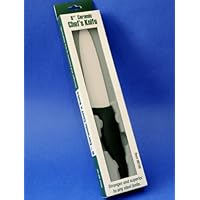 The fact that you are even reading this suggests that you already know the arguments in favor of ceramic knives. Ceramic knives are harder than steel knives, can be made much sharper than steel knives, hold their edge ten times longer than steel knives, are lighter than steel knives, won't brown foods, transfer a metallic taste or smell, or rust.
The fact that you are even reading this suggests that you already know the arguments in favor of ceramic knives. Ceramic knives are harder than steel knives, can be made much sharper than steel knives, hold their edge ten times longer than steel knives, are lighter than steel knives, won't brown foods, transfer a metallic taste or smell, or rust.You probably also know the disadvantages of ceramic knives. Unlike steel knives ceramic knives can chip or break so you want to avoid dropping them, tossing them in a sink or kitchen drawer, or arguably even washing them in a dishwasher. (Most ceramic knives come in fitted plastic packing material that can be saved, or you can store them in something like this Kyocera Bamboo 3-Slot Knife Block.) If you actually succeed in dulling a ceramic knife, it will need to be professionally sharpened, though Kyocera has come out with a sharpener for home use: Kyocera Electric Diamond Knife Sharpener for Kyocera Ceramic Knives. Unlike steel knives ceramic knives cannot flex without breaking so there can be no such thing as a ceramic boning knife, and you only want to use ceramic knives to cut boneless meats. Finally, although using a proper cutting board is a good idea with fine steel knives, it is an absolute requirement with ceramic knives; using a ceramic knife to cut something on a plate is an absolute no-no.
So the only remaining question is whether to go cheap: Harbor Freight Tools Ceramic 6 Inch Chef's Knife or expensive: Kyocera Revolution Series Ceramic 6 Inch Chef's Knife, and due to the fortuitous timing of a couple of good sales I can offer an opinion.
Blade: Both the Harbor Freight and the Kyocera Revolution blades are double beveled. Kyocera's claims that its micro-grain ceramic is more dense than its competitors should result in a sharper blade, but any difference was too subtle for me to detect. Both knives will be MUCH sharper than any steel knife you are used to, cutting through citrus rinds (and even seeds!) like butter.
Handle: Both the Harbor Freight and Kyocera Revolution have superficially similar ergonomic handles, but I noted a couple of significant differences. In the Harbor Freight the finger guard is part of the handle while in the Kyocera Revolution it is part of the blade. Surprisingly, I found the Kyocera Revolution handle a bit slippery, which in light of the consequences of dropping it is significant. The tackier surface of the Harbor Freight handle provided me with a surer grip.
Color: The Kyocera Revolution chef's knife is available in a larger size:
Kyocera Revolution Series Ceramic 7 Inch Chef's Knife,
and one other blade color:
Kyocera Revolution Series Ceramic 6 Inch Chef's Knife Black Handle, Black Blade,
Kyocera Revolution Series Ceramic 7 Inch Chef's Knife Black Handle, Black Blade;
the Harbor Freight ceramic chef's knife is available in one size and one color.
Sharpening: If you manage to dull your Kyocera Revolution knife, Kyocera will sharpen it in return for shipping and handling; if you manage to dull your Harbor Freight knife, you are on your own.
Price: This obviously varies but in most cases you can expect to pay four times as much for the Kyocera Revolution chef's knife as for the Harbor Freight chef's knife.
Note: A Harbor Freight Tools Ceramic 5 Inch Utility Knife and a Harbor Freight Tools Ceramic 3 Inch Paring Knife are also available.I like to cook, and I have a drawer full of knives. While stainless steel looks good, I usually reach for my 40 year old Sabatier chef's knife, or a very similar Japanese knife that a friend brought back from a Tokyo department store. (It's not one of those super-premium knives.) I was intrigued by the ceramic "sharper that anything else" hype, although a little put off by the notion of a blade that wouldn't respond to my trusty old whet stones. I used the knife, and it was good, but not so extraordinary that I felt I should replace my other knives. Then one day I dropped the knife onto our ceramic tile kitchen floor. It broke right in half, leaving a useless one-inch stub above the handle. The pieces went into the trash, and my curiosity was satisfied. At least I hadn't paid a premium price. Given the difficulties of repairing chips to the ceramic blade edge, and the need for special sharpening tools, I'm sticking with my trusty carbon steel. Happy slicing!I just bought one of these knives this week and since I have a local Harbor Freight outlet nearby I went there and got it much cheaper too.. It is my second ceramic since buying a 4" Master Class ceramic utility knife not long ago at TJ Max for $8 to try a ceramic out. I have many knives and a strong interest in them and really enjoy the ceramics now. This 6" knife is very sharp and is a pleasure to use on ripe tomatos and olives and other softer veggies although it is by no means a replacement for steel knives but rather an enhancement for kitchen prep. Carrots, potatos and other large or hard skinned veggies are better cut with a steel knife. I fully understand that ceramic is delicate so I'm extra careful as to not damage my new knives (no chopping or poking). I would have given it 5 stars if it came with a sheath to protect the blade as my Master Class knife did..

0 comments:
Post a Comment